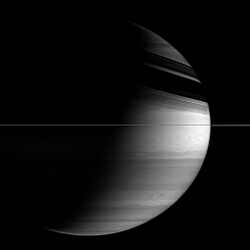
Detailed view of Saturn’s clouds. Image credit: NASA/JPL/SSI. Click to enlarge
This clear view of Saturn shows the planet’s stormy bands, especially near the equator. The northern boundary of the bright equatorial zone is shearing against the band to the north, and producing tremendous turbulence. Two storms are also merging together in the planet’s southern hemisphere. This photo was taken on March 16, 2006 when Cassini was approximately 2 million kilometers (1.3 million miles) from Saturn.
This remarkably detailed view of Saturn’s clouds reveals waves at the northern boundary of the bright equatorial zone, presumably associated both with the strong wind shear there and also the difference in density across the boundary with the band to the north. The intense eastward-flowing jet at the equator makes the edges of the equatorial zone among the most strongly sheared on the planet.
To the south, two dark ovals embrace, while dark ring shadows blanket the north. The moon Janus (181 kilometers, or 113 miles across) occupies a mere two pixels beneath the rings, at right of center.
The image was taken with the Cassini spacecraft wide-angle camera on March 16, 2006, using a filter sensitive to wavelengths of infrared light centered at 728 nanometers. The view was acquired at a distance of approximately 2 million kilometers (1.3 million miles) from Saturn. The image scale is 118 kilometers (73 miles) per pixel.
The Cassini-Huygens mission is a cooperative project of NASA, the European Space Agency and the Italian Space Agency. The Jet Propulsion Laboratory, a division of the California Institute of Technology in Pasadena, manages the mission for NASA’s Science Mission Directorate, Washington, D.C. The Cassini orbiter and its two onboard cameras were designed, developed and assembled at JPL. The imaging operations center is based at the Space Science Institute in Boulder, Colo.
For more information about the Cassini-Huygens mission visit http://saturn.jpl.nasa.gov . The Cassini imaging team homepage is at http://ciclops.org .
Original Source: NASA/JPL/SSI News Release
